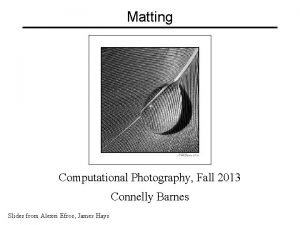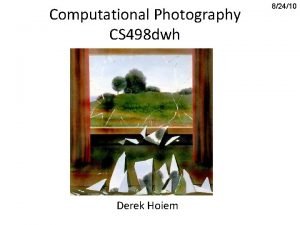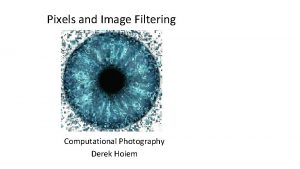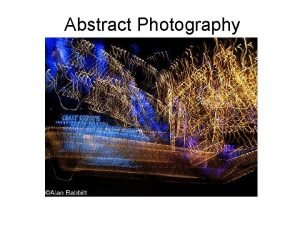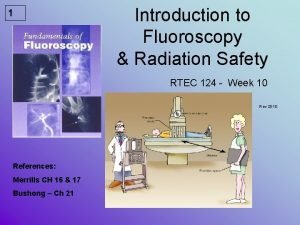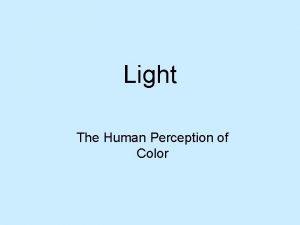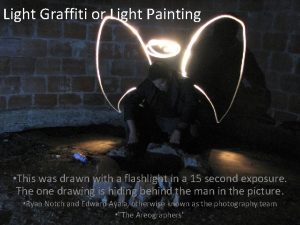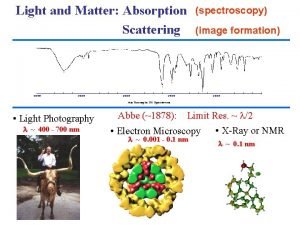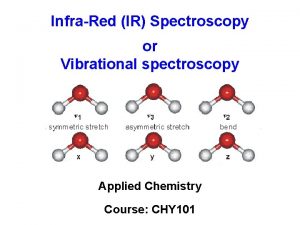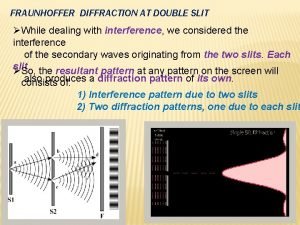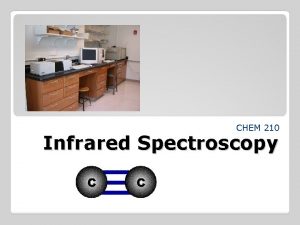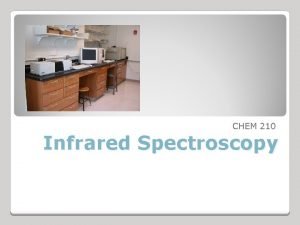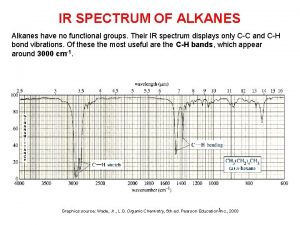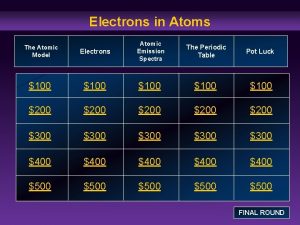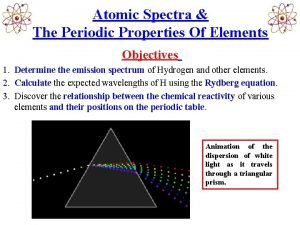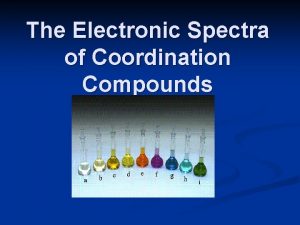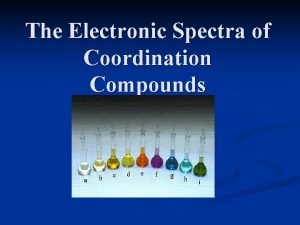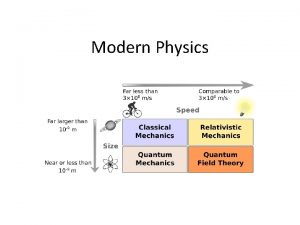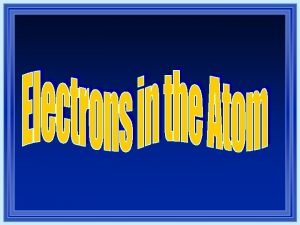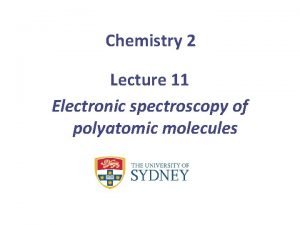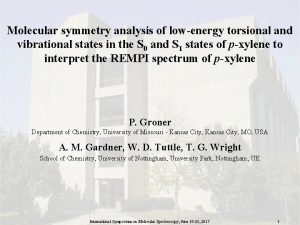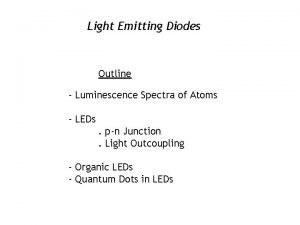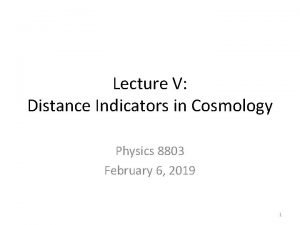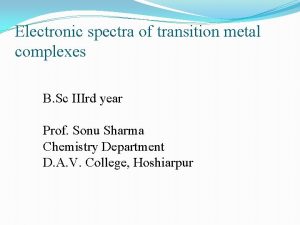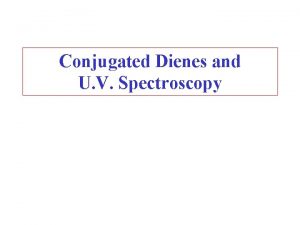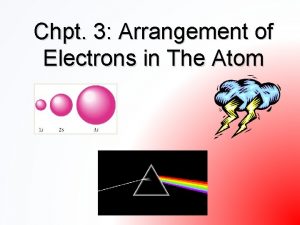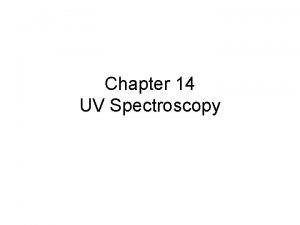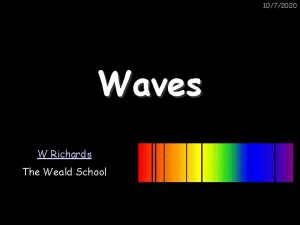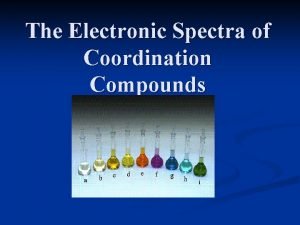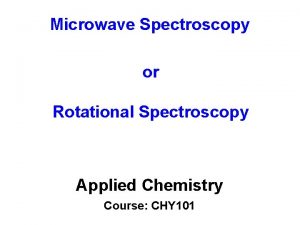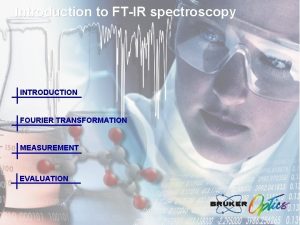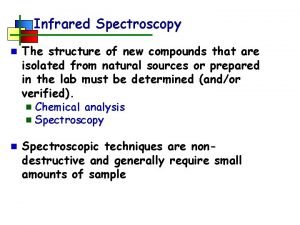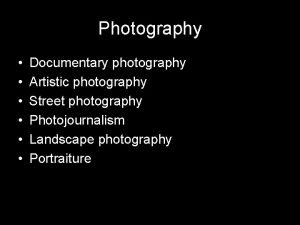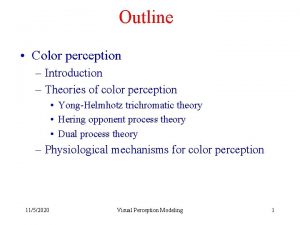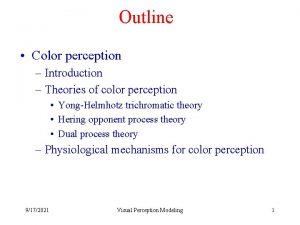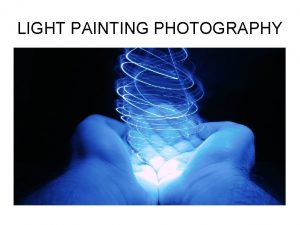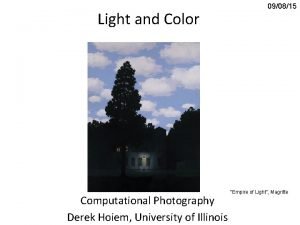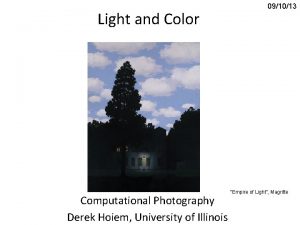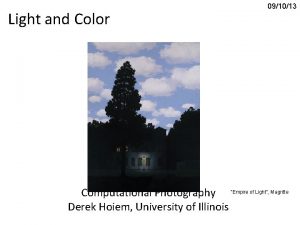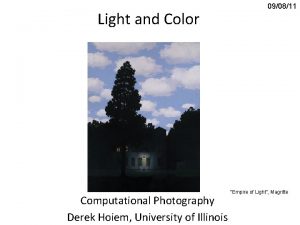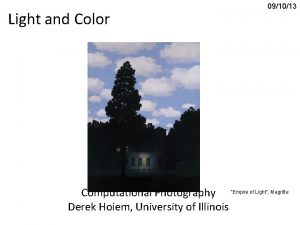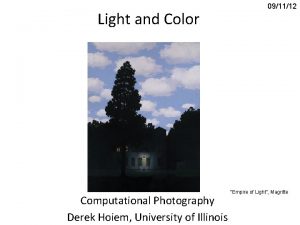Computational Photography Color perception light spectra contrast Connelly













































- Slides: 45

Computational Photography: Color perception, light spectra, contrast Connelly Barnes

Color Perception, etc ● Previously: ○ Camera obscura / pinhole camera ○ Cameras with lenses ○ Modeling camera projections

Color Perception, etc ● Today: ○ Human / electronic eyes ○ Electromagnetic spectrum ○ Color spaces Various slides by Alexei Efros, Fredo Durand, James Hays

Image Formation Digital Camera Film The Eye Slide by Efros

Sensor Array CMOS sensor CCD sensor Slide by Efros

Sampling and Quantization

Interlace vs. progressive scan http: //www. axis. com/products/video/camera/progressive_scan. htm Slide by Steve Seitz

Progressive scan http: //www. axis. com/products/video/camera/progressive_scan. htm Slide by Steve Seitz

Interlace http: //www. axis. com/products/video/camera/progressive_scan. htm Slide by Steve Seitz

Rolling Shutter SLR cameras at high shutter speed, most CMOS cameras

The Eye The human eye is a camera! Iris - colored annulus with radial muscles Pupil - the hole (aperture) whose size is controlled by the iris What’s the “film”? photoreceptor cells (rods and cones) in the retina Slide by Steve Seitz

The Retina

Two types of light-sensitive receptors Cones cone-shaped less sensitive operate in high light color vision Rods rod-shaped highly sensitive operate at night gray-scale vision © Stephen E. Palmer, 2002

Rod / Cone sensitivity

Some Goals of Human Eye • Recognize food • Recognize friends, mates • Detect predators • Navigation -- identify 3 D structure Limited memory, computation budget • Highest resolution in fovea - (2 degrees, 50% of visual cortex) • Absolute luminance discarded • Edges, corners retained • Store only a tiny fraction of what is observed

Visual Clutter - Bandwidth Overload

Eye Movements Motion Magnification -- Eye Movements

Electromagnetic Spectrum Human Luminance Sensitivity Function http: //www. yorku. ca/eye/photopik. htm

Visible Light Why do we see light of these wavelengths? …because that’s where the Sun radiates EM energy © Stephen E. Palmer, 2002

The Physics of Light Any patch of light can be completely described physically by its spectrum: the number of photons (per time unit) at each wavelength 400 - 700 nm. © Stephen E. Palmer, 2002

The Physics of Light Some examples of the spectra of light sources © Stephen E. Palmer, 2002

The Physics of Light % Photons Reflected Some examples of the reflectance spectra of surfaces Yellow Red 400 700 400 Purple Blue 700 400 Wavelength (nm) 700 400 700 © Stephen E. Palmer, 2002

Ordinary Human Vision (Trichromatism)

Perceptual Sensitivity ITU Recommendation for HDTV: Y = 0. 21 R + 0. 72 G + 0. 07 B Evolved to detect vegetation, berries?

Tetrachromatism Bird cone responses Most birds, and many other animals, have cones for ultraviolet light. Some humans, mostly female, seem to have slight tetrachromatism.

Color Spectra metamers

Slide by Fredo Durand

Slide by Fredo Durand

Slide by Fredo Durand

Slide by Fredo Durand

Color Image R G B

Images in Python/MATLAB • Image as array: h x w x channels I(y, x, channel) • Red channel, upper left corner: MATLAB: I(1, 1, 1), Python: I[0, 0, 0] row column 0. 92 0. 95 0. 89 0. 96 0. 71 0. 49 0. 86 0. 96 0. 69 0. 79 0. 91 R 0. 93 0. 94 0. 97 0. 62 0. 37 0. 85 0. 97 0. 93 0. 92 0. 99 0. 82 0. 89 0. 56 0. 31 0. 75 0. 92 0. 81 0. 95 0. 91 0. 72 0. 92 0. 51 0. 93 0. 55 0. 94 0. 51 0. 97 0. 42 0. 62 0. 57 0. 37 0. 41 0. 85 0. 49 0. 97 0. 91 0. 93 0. 92 0. 99 0. 95 0. 88 0. 89 0. 94 0. 82 0. 56 0. 89 0. 46 0. 56 0. 91 0. 31 0. 87 0. 75 0. 90 0. 92 0. 97 0. 81 0. 95 0. 91 0. 920. 51 0. 930. 55 0. 940. 51 0. 970. 42 0. 620. 57 0. 370. 41 0. 850. 49 0. 970. 910. 930. 92 0. 81 0. 89 0. 81 0. 72 0. 87 0. 57 0. 37 0. 80 0. 88 0. 89 0. 79 0. 85 0. 950. 88 0. 890. 94 0. 820. 56 0. 890. 46 0. 560. 91 0. 310. 87 0. 750. 90 0. 920. 970. 810. 95 0. 62 0. 96 0. 60 0. 95 0. 58 0. 50 0. 60 0. 58 0. 50 0. 61 0. 45 0. 33 0. 890. 81 0. 720. 87 0. 510. 57 0. 550. 37 0. 510. 80 0. 420. 88 0. 570. 89 0. 410. 790. 490. 850. 91 0. 84 0. 71 0. 74 0. 81 0. 58 0. 51 0. 39 0. 73 0. 92 0. 91 0. 49 0. 74 0. 960. 60 0. 950. 58 0. 880. 50 0. 940. 60 0. 560. 58 0. 460. 50 0. 910. 61 0. 870. 450. 900. 330. 97 0. 67 0. 49 0. 54 0. 62 0. 85 0. 48 0. 37 0. 88 0. 90 0. 94 0. 82 0. 93 0. 710. 74 0. 810. 58 0. 810. 51 0. 870. 39 0. 570. 73 0. 370. 92 0. 800. 91 0. 880. 490. 890. 740. 79 0. 49 0. 86 0. 56 0. 84 0. 66 0. 43 0. 42 0. 77 0. 73 0. 71 0. 90 0. 99 0. 490. 54 0. 620. 85 0. 600. 48 0. 580. 37 0. 500. 88 0. 600. 90 0. 580. 94 0. 500. 820. 610. 930. 45 0. 73 0. 96 0. 90 0. 67 0. 33 0. 61 0. 69 0. 73 0. 97 0. 860. 56 0. 840. 66 0. 740. 43 0. 580. 42 0. 510. 77 0. 390. 730. 71 0. 920. 900. 910. 990. 49 0. 94 0. 69 0. 89 0. 49 0. 41 0. 78 0. 77 0. 89 0. 93 0. 79 0. 730. 960. 900. 670. 540. 330. 850. 610. 480. 690. 370. 790. 880. 730. 900. 930. 940. 970. 82 0. 91 0. 940. 690. 890. 490. 560. 410. 660. 780. 430. 780. 420. 770. 890. 730. 990. 710. 930. 90 0. 79 0. 73 0. 90 0. 67 0. 33 0. 61 0. 69 0. 73 0. 91 0. 94 0. 89 0. 41 0. 78 0. 77 0. 89 0. 99 G 0. 99 0. 91 0. 92 0. 95 0. 85 0. 33 0. 74 0. 93 0. 99 0. 97 0. 93 B

Color spaces: RGB Default color space 0, 1, 0 R (G=0, B=0) G 1, 0, 0 (R=0, B=0) 0, 0, 1 Some drawbacks B (R=0, G=0) • Strongly correlated channels • Non-perceptual Image from: http: //en. wikipedia. org/wiki/File: RGB_color_solid_cube. png

Color spaces: HSV Intuitive color space H (S=1, V=1) S (H=1, V=1) V (H=1, S=0)

Color spaces: L*a*b* “Perceptually uniform” color space L (a=0, b=0) a (L=65, b=0) b (L=65, a=0)

White Balance Slide by Alexei Efros

Problem: Dynamic Range The real world is High dynamic range 1 1500 25, 000 400, 000 2, 000, 000 Slide by Alexei Efros

Is Camera a photometer? Image pixel (312, 284) = 42 42 photons? Slide by Alexei Efros

Long Exposure Real world Picture 10 -6 High dynamic range 10 -6 106 0 to 255 Slide by Alexei Efros

Short Exposure Real world Picture 10 -6 High dynamic range 10 -6 106 0 to 255 Slide by Alexei Efros

Image Acquisition Pipeline Lens scene radiance Shutter sensor irradiance 2 (W/sr/m ) ò sensor exposure Dt CCD ADC analog voltages Remapping digital values Camera is NOT a photometer! pixel values

Varying Exposure

What does the eye sees? The eye has a huge dynamic range Do we see a true radiance map?

Eye is Not a Photo-meter

Eye is Not a Photo-meter
 Connelly barnes
Connelly barnes Computational photography uiuc
Computational photography uiuc Computational photography uiuc
Computational photography uiuc Light light light chapter 23
Light light light chapter 23 Light light light chapter 22
Light light light chapter 22 Chapter 22
Chapter 22 Is abstract photography same as conceptual photography
Is abstract photography same as conceptual photography Double contrast vs single contrast
Double contrast vs single contrast Color perception examples
Color perception examples Light graffiti photography
Light graffiti photography Light and matter photography
Light and matter photography Paramount lighting
Paramount lighting Iron carbonyl fe co 5 is
Iron carbonyl fe co 5 is Spectra tips
Spectra tips Spectra shropshire
Spectra shropshire Ir spectrum aromatic ring
Ir spectrum aromatic ring Fraunhoffer diffraction
Fraunhoffer diffraction Propionic anhydride ir spectrum
Propionic anhydride ir spectrum Nitro group ir peak
Nitro group ir peak Atomic emission spectra and the quantum mechanical model
Atomic emission spectra and the quantum mechanical model Azza spectra
Azza spectra Ir spectrum of nitrile
Ir spectrum of nitrile Atomic emission spectra periodic table
Atomic emission spectra periodic table Periodic table of spectra
Periodic table of spectra Atomic emission spectra and the quantum mechanical model
Atomic emission spectra and the quantum mechanical model Microstate table for p2
Microstate table for p2 Electronic spectra of coordination compounds
Electronic spectra of coordination compounds Line spectra
Line spectra Emission and absorption spectra grade 12
Emission and absorption spectra grade 12 Why are atomic emission spectra discontinuous
Why are atomic emission spectra discontinuous What is racah parameter
What is racah parameter Electronic spectra of polyatomic molecules
Electronic spectra of polyatomic molecules Ir peak table
Ir peak table Vibronic spectra
Vibronic spectra Outline spectra
Outline spectra Supernova spectra
Supernova spectra Limitations of orgel diagram
Limitations of orgel diagram Double bond extending conjugation
Double bond extending conjugation Heisenberg uncertainty principle
Heisenberg uncertainty principle Conjugation in spectroscopy
Conjugation in spectroscopy Weald to waves
Weald to waves Correlation diagram in coordination chemistry
Correlation diagram in coordination chemistry Electromagnetic spectrum chart
Electromagnetic spectrum chart Rotational motion
Rotational motion Ftir spectra
Ftir spectra Ir spectroscopy table
Ir spectroscopy table
